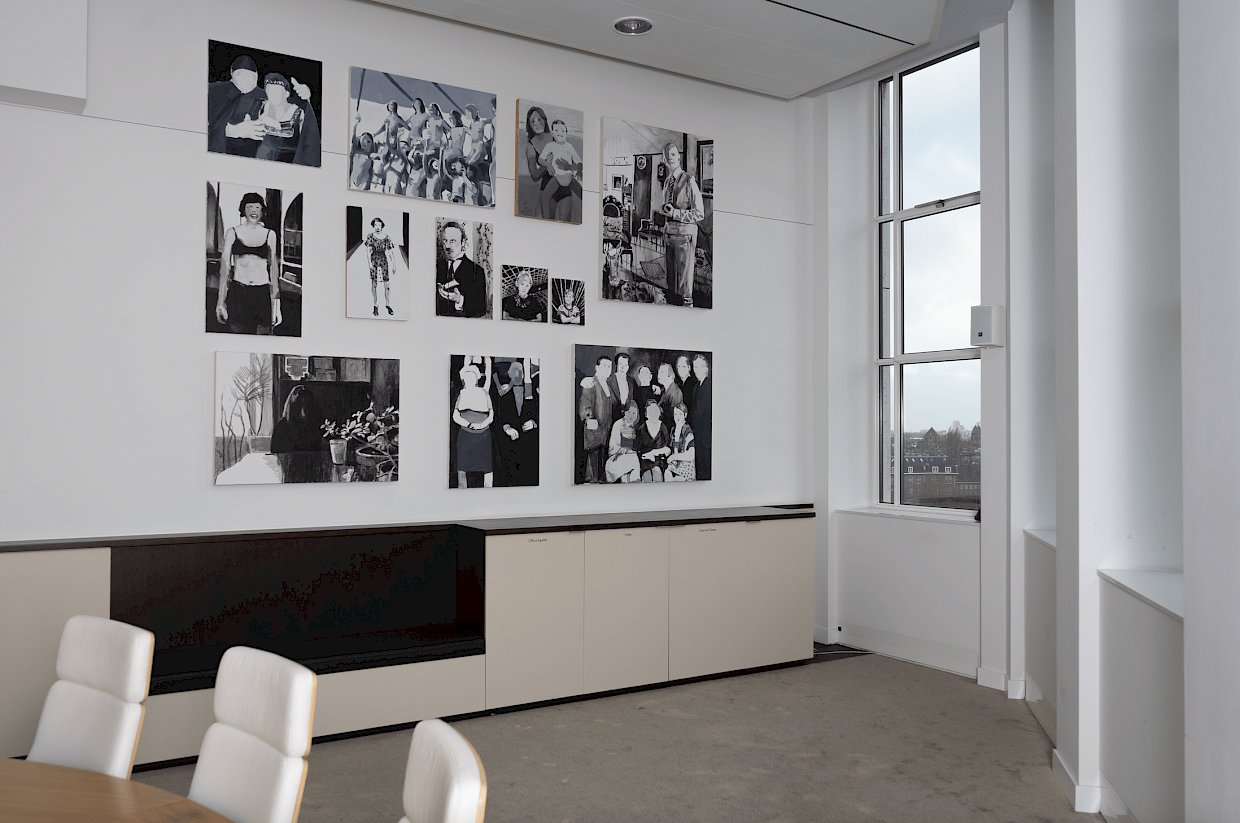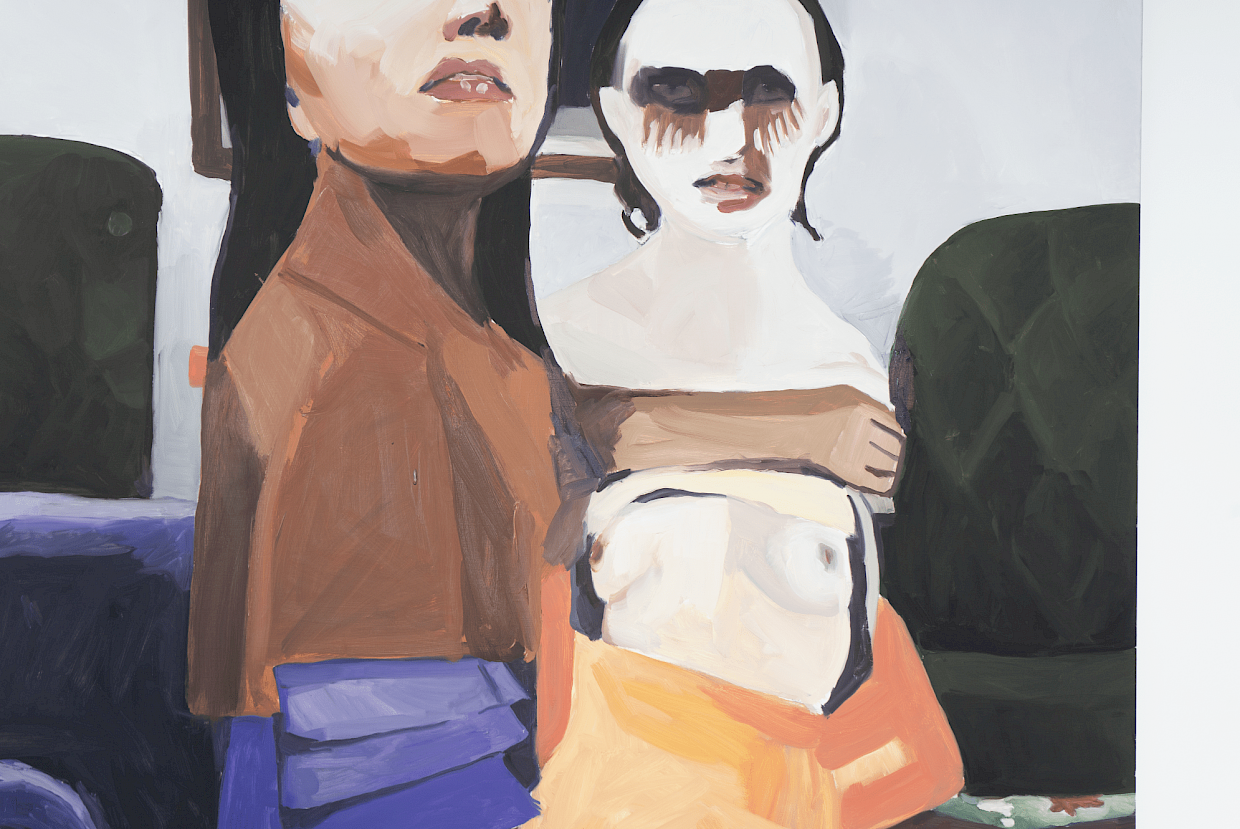

Helen Verhoeven (b. 1974)
Helen Verhoeven

Upon returning to the Netherlands, Helen Verhoeven had to deal with the biological fact that she is the daughter of “that famous film director”. That is the reason why the majority of the public was initially quite sceptical about her work. Raised in Los Angeles, she attended art schools in San Francisco and New York before starting her residency at the Rijksakademie (State Academy of Fine Arts) in 2005. After a number of exhibitions, Verhoeven managed to silence her critics and attracted the attention of many museums and collectors. Her large paintings are filled with countless figures in indefinable situations and apparent ritual gatherings. In addition, Verhoeven creates grouped paintings that relate to each other, even though their mutuality isn’t certain. The different formats are hung in a fixed style: above, below and next to each other in a tableau.
A striking and common aspect in her work is the presence of naked ladies and young girls. Verhoeven finds it fascinating to paint the different life stages and phase-related roles of women. The general lack of clarity is manifest in almost all of her work. Time, place and space, as well as the presence of opposites such as good-evil and power-impotence, are often tangible, but hard to identify. The artist herself sometimes does not know exactly what is going on, and Verhoeven is extremely fond of this uncertainty. She argues that this happens naturally during the process of creation when, as if it were beyond her control, more and more figures slowly enter the composition. She doesn’t like things to be decided and identified in advance. Not only does this keep the creative quest exciting, but also its outcome.
Verhoeven has a characteristic way of painting, a bit stiff and naive, which makes the figures reminiscent of dolls. While practising this style of painting, she reproduces (excerpts of) photos, which often come from the art, media and film scene. The family and holiday snaps she uses often come from her own family. The black and white portraits with grey tones have a nostalgic look and feel. Therefore, it exudes the atmosphere of an enlarged, old-fashioned photo album. In addition, Verhoeven frequently quotes from her own work and that of famous masters. For example, the painting at the top left is clearly derived from Rembrandt’s The Jewish Bride. Verhoeven allows herself ample freedom to borrow such images.
Helen Verhoeven (b. 1974)
Mother 9

The fact that Helen Verhoeven likes to depict the different phases of a woman’s life and the various roles she takes on during it, is clearly apparent from this painting Mother 9, which was part of the exhibition carrying the same name at the Stigter & Van Doesburg gallery in Amsterdam in 2013, together with a dozen other works.
The woman and her role as a mother has been an important and frequently discussed subject in (Western) visual arts for centuries. Just think of the countless depictions of “Mary with child” in Christian iconography in which the mother is always the attentive and loving caretaker of her offspring.
In this series of paintings by Verhoeven, little can be seen of that sweet and nurturing mother ideal. The titles of the works in the Mother series all contain a number, which is illustrative of the standoffish portrayals. The women depicted directly face the viewer with straight faces and hollow eyes, holding children of different ages in their arms or on their laps. There is no sign of affection, no look or gesture confirming an intimate bond between mother and child. It’s as if motherhood doesn’t interest them, as if they’ve been forced into that role. Their children look innocent and seem oblivious to their mothers’ state of mind. The background consists of carpets and blankets with rich, decorative motifs, which allow Verhoeven to show off her clever painting technique to her heart’s content.
In Mother 9, a mother and her adolescent daughter are right next to each other in a living room. The mother looks away while her daughter looks straight at the viewer. Her breasts are bare, her eyes rimmed with (smeared) make-up. Two chairs are placed on either side of the room. Besides a painting, plates are attached to the wall for decoration. The austere interior hardly offers any clues about the background and the circumstances of the scene.
Some interpretations of this work fit the image of a loving mother, while others are grimmer, because it’s hard to tell whether the arm covering and protecting the girl’s upper body is the mother’s or the daughter’s. It is not clear to see. Is the mother trying to stop her adolescent daughter from wearing make-up and offensive clothing or is she pushing for it? Is the daughter already starting to show the same traits as her mother? Behind the pair hangs the ominous painting, featuring the silhouette of a figure with raised arms. It is reminiscent of a distraught figure in Pablo Picasso’s famous painting Guernica. Its frame encompasses the heads of the two figures, as if to emphasise that they must be there for each other. So perhaps Verhoeven’s intention is for this to be a warning against abuse of power? We can’t be sure. The associations and interpretations constantly change, as if, just like in a detective or thriller, the artist wants to leave the viewer in the unknown about whether a character is good or bad. This work is open-ended. That uncertainty in viewing the work is exactly what Verhoeven wants to achieve.
